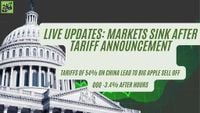In a dramatic turn of events, the Trump Administration unveiled its new tariff policies on April 2, 2025, during a high-profile event dubbed 'Liberation Day.' The announcement has sent ripples through the financial markets, leading to significant declines in stock prices, particularly for tech-heavy ETFs like Invesco QQQ.
The newly announced reciprocal tariffs vary widely, ranging from a modest 10% on countries such as Singapore to a staggering 50% on others. Notably, China will face a reciprocal tariff of 34%, which effectively rises to 54% due to a previously imposed 20% tariff. This steep increase has raised concerns among investors about the potential impact on the U.S. economy, with fears of a recession looming large.
According to President Trump, the tariffs aim to counteract what his administration describes as currency manipulation and trade barriers imposed by foreign nations. The tariffs will take effect on April 9, 2025, with a notable 25% tariff on all foreign-made automobiles beginning at 12:01 a.m. on April 10.
As the market reacted to the news, futures indicated a downward trend. By 5:25 p.m. ET on April 2, Dow Futures were projected to open down by 0.49%, S&P Futures by 1.58%, and Nasdaq Futures by 2.31%. The Invesco QQQ Trust, which tracks the Nasdaq 100 index, saw a sharp decline of 3.43%, reflecting broader market apprehension.
The table below illustrates the announced tariffs against various countries:
Country | Tariffs Charged to U.S. | U.S.A. Discounted Reciprocal Tariffs
China | 67% | 34%
Japan | 46% | 24%
Singapore | 10% | 10%
Sri Lanka | 88% | 44%
Israel | 33% | 17%
Despite the administration's claims, many analysts suggest that the actual tariffs imposed by these countries are significantly lower than reported. This discrepancy raises questions about the Trump Administration's reliance on self-reported figures to justify the announced tariffs.
Market analysts had anticipated a more moderate approach, with hopes for tariffs closer to 10% that could have spurred a rally. Instead, the steep tariffs have solidified fears that the U.S. economy may be headed for turbulent times, with inflation rates potentially rising as well.
In a separate but related development, Invesco QQQ shares experienced a 1.9% drop during mid-day trading on March 28, 2025, trading as low as $471.96. The stock's decline was exacerbated by a significant drop in trading volume, which fell by 55% from the average daily volume. This downturn reflects broader market trends as investors react to the impending tariffs.
Invesco QQQ's recent performance highlights the volatility in tech stocks, with the ETF's price fluctuating around a fifty-day moving average of $506.34 and a 200-day average of $505.30. The company's market capitalization stands at $300.27 billion, with a price-to-earnings ratio of 30.05.
Adding to the uncertainty, Invesco recently declared a dividend of $0.7157, which will be issued on April 30, 2025, to stockholders of record as of March 24, 2025. This announcement may provide some relief to investors amid the tumultuous market conditions.
Institutional investors have been actively reshuffling their stakes in Invesco QQQ, with PayPay Securities Corp increasing its holdings by a staggering 276.9% in the fourth quarter. Other firms, including Bridge Generations Wealth Management and Marshall & Sterling Wealth Advisors, have also made notable adjustments to their positions in the ETF.
As the markets brace for the full impact of the newly announced tariffs, analysts are left questioning the sustainability of the recent rally seen in the stock market. The uncertainty surrounding potential retaliatory measures from other countries adds a layer of complexity to the economic outlook.
In a related market response, President Trump's tariffs have led to a significant drop in the Invesco QQQ ETF, which fell by 3% in after-market trading on April 2, 2025. This decline marks a notable shift for the index, which had previously enjoyed a more favorable trading environment.
With the markets now facing heightened volatility, investors are keenly watching for any signs of retaliatory tariffs from affected countries, which could exacerbate the current economic climate. The administration's aggressive stance may lead to a tit-for-tat scenario that could further destabilize global trade relations.
As the situation unfolds, all eyes will be on how the markets respond to the tariffs and whether the anticipated recession materializes. The coming weeks will undoubtedly be critical for investors as they navigate this new landscape of trade policy and its implications for the economy.
In summary, the Trump Administration's tariff announcement has sent shockwaves through the markets, prompting fears of a recession and raising questions about the future of U.S. trade relations. As the tariffs take effect, the economic landscape remains uncertain, and investors are bracing for potential fallout.






